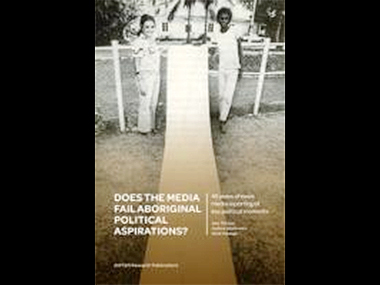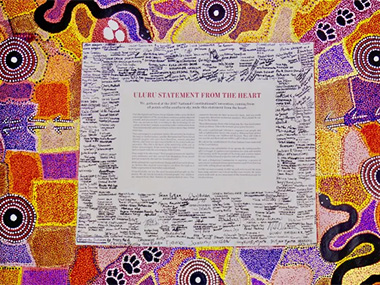Media Muddles Aboriginal Politics

The book's cover featuring a 1972 photo of Tessa Ferguson and Edwin Jangalaros presenting the thousand signature Larrakia Petition outside Government House in Darwin
Jeremy Eccles | 21.05.20
Author: Jeremy Eccles
News source: Review
A fascinating study of 45 years' media coverage of important Indigenous issues, beginning with the Larrakia Petition in 1972, concludes that, at last, “Aboriginal people appear to be effectively shaping the media discourse on Aboriginal issues”.
But it's been a divisive battle, and, even at the end, 'The Australian' – notorious for its unhelpful coverage of Indigenous matters, can put in the knife by asserting that the Uluru Statement's claims can be supported because they don't “contest the authority of the settler order”!
This book – going under the overly academic title of 'Does the Media Fail Aboriginal Political Aspirations?' - is a UTS effort for AIATSIS, commissioned by the NSW Aboriginal Affairs Department in 2019, and produced at a breakneck pace. It should be noted that NSW is not at the forefront politically of Aboriginal advancement, given that Victoria and the NT are working towards treaties with their First Nations peoples while NSW is only promising “fundamental change in the relationship between the government and Aboriginal communities”.
And that brings me to the fraught matter of treaties in this book. While it covers the unknown (to me, and I suspect many Aussies) history of the Aboriginal Treaty Committee under the excellent HC 'Nugget' Coombs, which spent three years attempting to interest Malcolm Fraser in the idea of a treaty, it fails to mention that the first reference I've found to the need for such a treaty was in the 1830s in Van Dieman's Land (Tassie) when the Chief Justice, Sir John Pedder (after whom the lake was named) thought it a much better idea than exiling the few Tasmanians who'd survived the Black War to Flinders Island in the Bass Strait.
Coombs's ATC received virtually no coverage outside the Canberra bubble – five out of six reports were in the 'Canberra Times' - and ultimately fell foul of the new and rising Federation of Aboriginal Land Councils which decided his treaty was all about providing comfort for white Australians over the dodgy legality of their colonialism.
This raises a small issue of how the three authors of the book – Amy Thomas, Andrew Jakubowicz and Heidi Norman – selected their media for review. Unfortunately, they had to rely only on printed sources – so we basically get 'The Australian' versus the 'Sydney Morning Herald' beside the 'Canberra Times' and, out on a limb, the 'Koori Mail'. Only right at the end does online ABC material get added.
Let's take their study of Paul Keating's 1992 'Redfern Speech'. Amazingly, they can claim it was “not embraced” at first – by the media, I assume. For it certainly turned reluctant heads in the Redfern crowd and whet my appetite. And Noel Pearson hailed “a seminal moment” (of which there have been far too many!). But the summations of the newspapers were classic: “Aboriginal Malaise” in 'The Australian'; “Plea for the Dispossessed” in SMH; the double-edged “Keating's Black Heart” in the 'Koori Mail', suggesting the PM was out for the compassionate vote in the 1993 election; and “Apology Wins Black Praise” in the 'Canberra Times'.
But an interesting thought arising from 'The Australian's constant efforts to discover Aboriginal disunity is that, just possibly, this encouraged the massive effort at cohesion in the Uluru Statement process 25 years later.
Of course, we all know how well non-Indigenous politicians agree on important matters so the media's “failure to represent Aboriginal agency and account for the complexity of Aboriginal polity” isn't really justified. But how hard would it be to sell a story to an editor based on words like “agency” and “self-determination” which are peppered throughout this book. Thus the researchers found that “the media was implicated in the dismantling of ATSIC” by the Howard government, taking the easy line of only reporting its views. And even in the much more nuanced coverage of Uluru, the media often failed to distinguish between the Aboriginal Voice to Parliament, a treaty, a Makarrata and constitutional recognition.
Mind you, the real power was revealed in Uluru coverage by 'The Australian's Greg Sheridan who declared constitutional change was doomed, for citizens would be divided even before the Statement had been drawn up! And didn't Malcolm Turnbull parrot him precisely when offered the chance to embrace that change.
I hasten to say that I began to read the 'Weekend Australian' many years back partly because of the breadth of its Indigenous coverage under the editorship of Chris Mitchell and writers of the quality of Nicolas Rothwell. Now both have departed there seems little space for anything apart from climate denialism.
This excellently contextualised and referenced book regrettably leaves out coverage of John Howard's contentious watering down of the Wik High Court decision – though I'm glad to say there's an excellent documentary film on that matter, Dean Gibson's 'Wik v Queensland'.
The book sells at $40.
Share this:
»  del.icio.us
»
del.icio.us
»  Digg it
»
Digg it
»  reddit
»
reddit
»  Google
»
Google
»  StumbleUpon
»
StumbleUpon
»  Technorati
»
Technorati
»  Facebook
Facebook
Contact Details

The mutliply-signed and decorated Uluru Statement from the Heart, now three years old
Further Research
News Tags: Aboriginal Treaty Committee | ATSIC | Barunga Petition | Jeremy Eccles | Larakia Petition | Nugget Coombs | Redfern Speech | Uluru Statement
News Archive
- 27.05.20 | First Nations Arts Awards
- 21.05.20 | Media Muddles Aboriginal Politics
- 20.05.20 | The War in Mparntwe
- 18.05.20 | COOKED 2
- 14.05.20 | 'Truganini – Journey Through the Apocalypse'
- 11.05.20 | BIDYADANGA CLOSE-UP
- 07.05.20 | Boomerang Back to the Start
- 29.04.20 | Cooked???
- 24.04.20 | Mrs Ngallametta
- 23.04.20 | NATSIAA Pre-Selections Revealed
- 20.04.20 | CIAF 2020
- 16.04.20 | Kulinmaya! - Keep Listening!
- 15.04.20 | Nothing Revealed
- 10.04.20 | Marginally Good News
- 06.04.20 | ON & OFF IN ABORIGINAL ART
Advertising

